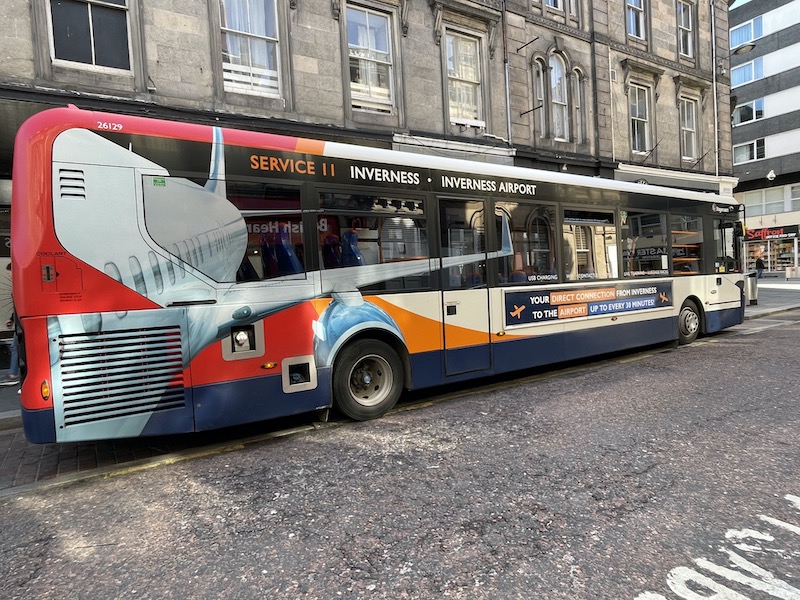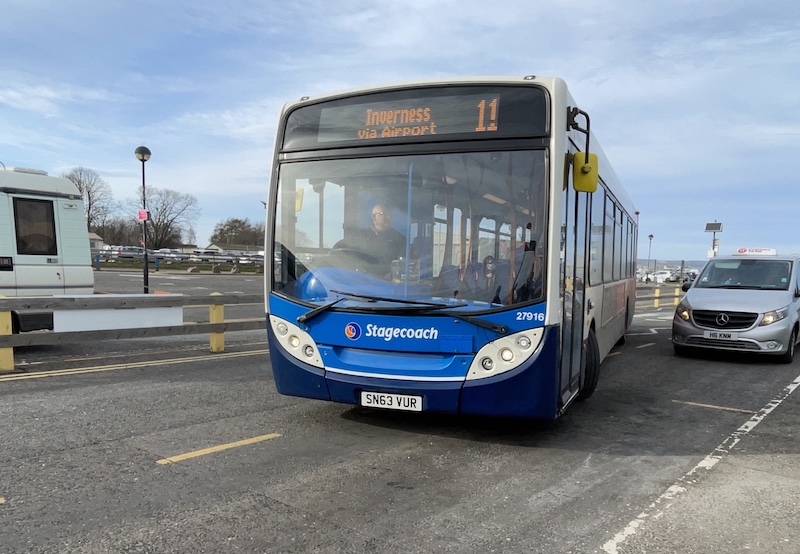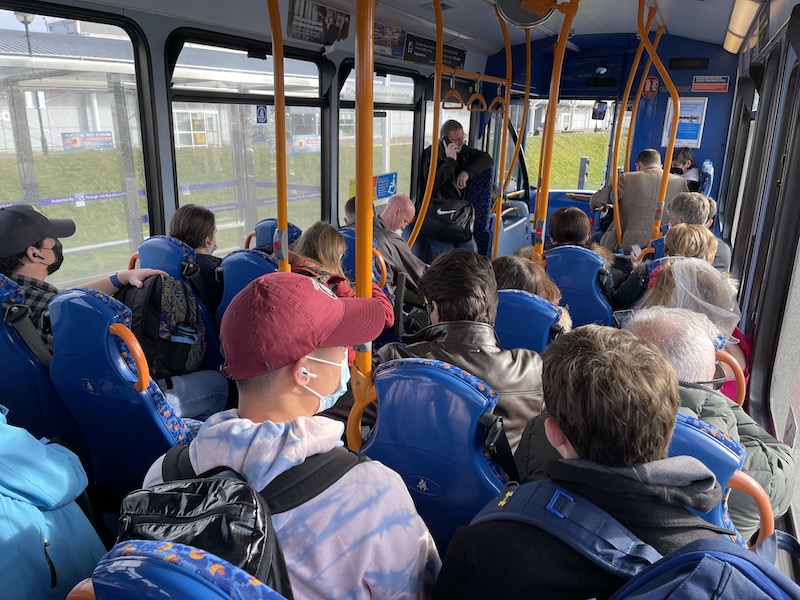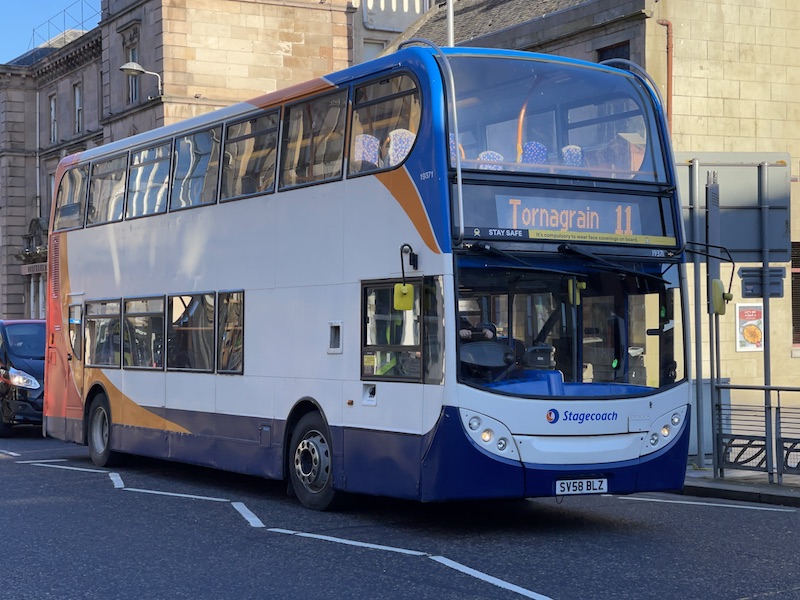Tuesday 22nd March 2022

Aside from the shiny new mega-size stations about to open in the Crossrail core there are quite a few other brand new stations currently under construction on the national network which are due to open during 2022. It’s a bit of a sweepstake to see which will open first.
There’s Reading Green Park and Thanet Parkway as well as Brent Cross West in the south and work has recently started in earnest on Portway (Park and Ride) near Bristol while in Scotland there’s Reston, north of Berwick-upon-Tweed expected to be ready for December and nearby East Linton next year
Even further north is Dalcross, sited nine miles east of Inverness on the line from Aberdeen on which another new station at Kintore opened in October 2020.
Work is now well underway on constructing the two new platforms at Dalcross on what will also be a doubling of the track at this location creating a new passing loop for trains.

There’ll also be a new footbridge and lifts and a nearby level crossing will close. It’s all costing £14 million – about average for a two platform, doubling track affair of this kind. There’ll be a modest size 64 space car park with the usual electric charging points and disabled bays. I assume the tariff will be devised to deter airport parkers.

Dalcross station has been in the planning since 2017 and work got underway in earnest last year. It’s aiming for a December opening.

I’ve been intrigued about the new Dalcross station ever since hearing the justification for it being adjacent to Inverness Airport. Whenever I’d been to the airport the railway seemed a fair distance from the terminal building – this isn’t a Gatwick or Stansted with the station adjacent to the terminal building – more a Luton in terms of the distance away.
But whereas Luton station has six trains an hour (and a frequent shuttle bus to the terminal building about to be replaced with a Direct Air Rail Transit), Dalcross will only have an hourly train service, which isn’t much good for airport passengers.
While catching flights from an airport always entails getting there with plenty of time to spare for security (even though that’s a doddle in my experience these days) it’s another matter landing and arriving when you don’t want to be hanging around for up to an hour for onward travel, not least because in normal times Stagecoach run a half hourly bus service (route 11) into Inverness which stops right outside the terminal building.

But the new railway station is sited some distance away making for a very inconvenient trek with luggage although I note Network Rail’s latest update reports “Hitrans has significantly upgraded the existing active travel path between the new station and the airport terminal”. I assume by “active travel” they mean walking and cycling but come on HiTrans, people going on holiday, or arriving back, aren’t going to cycle when encumbered with their luggage between station and airport, and won’t fancy a long walk either.
The blurb about the new station also refers to a half hourly bus link between the station and the airport which I’m assuming is the Stagecoach route 11 but realistically how many people are going to catch a half hourly bus from the airport for a five minute ride to a station to wait for an hourly train which is heading to the same destination (assuming Inverness rather than south to Aberdeen) as the bus. You’d just stay on the bus.

Ironically route 11 is currently on a Covid inspired reduced hourly frequency and I can vouch for how inconvenient this is as I flew into Inverness on Friday afternoon with a scheduled arrival of 15:15 and a scheduled bus departure either at 15:07 and 16:07.
I’d resigned myself to a 52 minute wait but in the event EasyJet did the business and landed at 15:07 while Stagecoach helped with modal integration by running eight minutes late meaning I was able to just catch the bus.

In fact impressively, so did 25 other passengers off that flight and it took the driver ten minutes to load us all – and at £5 each for the single fare it was nicely remunerative for Stagecoach.

It was a bit of a squeeze to get everyone on the single deck with their luggage and a shame Stagecoach had allocated the usual bus with additional racking (and that graphic of the aeroplane on the side) to a town route. Later I noticed a double deck bus allocated to the route which would have helped on the journey I made.

After encircling the western perimeter of the airport we passed alongside the works going on for the new station as we crossed over the line and headed into the city.

This gave me a chance to see the new platforms taking shape and pondering just what the purpose of this new station is.

Here’s a large scale OS map of the area showing the location of the new station and what I assume is the upgraded “active travel” route on the line of the original road access before a new ‘oxbow’ style diversion was built.

And here it is from Google maps.

It’ll be interesting to see how passengers and staff working at the airport take to this new travel facility once it opens – which is currently expected to be December 2022, although it looks to me as though there’s a fair amount of work yet to complete. My money would be on Spring 2023.
Finally for today a change of topic and a huge thanks to all those who responded with comments and suggestions to Sunday’s blog about jointly operated bus routes. The tally of commercially operated inter-urban routes remains at the eight listed but partnership arrangements in conurbations involving joint routes have now been expanded to include Merseyside and the West Midlands as well as an additional route in Sheffield. I’ve also added a few of the tendered routes readers highlighted where more than one operator runs the daytime service, including two of the TrawsCymru routes. The final list with added photographs can be found on my website on the home page menu and there’s a handy embedded link here.
Roger French
Blogging timeable: 06:00 TThSSu.
Next blog, Thursday 24th March 2022: I tried out the secret free bus travel offer in Newport.

The ‘active travel’ route doesn’t even follow the old road: it’s diverted further west (see https://goo.gl/maps/qkG3pNgR5J6NmRtn9 ). I make it about 1.5km from the terminal bus stop to the platform. How many people will want to do that with luggage? On a wet, wintry day? To catch an hourly train?
LikeLiked by 2 people
On the subject of tendered routes, I assume you weren’t counting routes where the commerical service is operated by one company and evening and Sunday services by someone else. I think Uno alone has three of these (242, 304 and 357).
LikeLike
An even stranger one is the Greenline 757. It is both Greenline and Easybus at the same time and they even charge different fares for traveling on the same bus
LikeLike
Charging different fares for the journey travelling on the same vehicle is nothing new: it’s how Stagecoach prices Megabus seats on its limited stop services such as the now withdrawn Hull-Leeds X62.
LikeLike
I think the tendering of evening services has been a ‘dodge’ by the commercial companies just to get subsidy; many – maybe most – of the evening journeys will be returns where the actual fare was taken earlier by the company – the council just pays for cost of the bus on the return trips! If there was no evening service provided, the commercial company would lose those return fares, so might actually continue to provide the evening services or, perhaps more likely – would simply cut most of the daytime journeys too!
It all seems rather typical of the modern commercial bus company attitude to accounting – rather than looking at the real contribution each journey makes to the network, they look only at cash taken on each route, or each journey. Thus, a bus which takes few fares in the evening – though it may carry a reasonable number of returning passengers – is seen as ‘requiring subsidy’ rather than as contributing to the income of the operation as a whole. I may be wrong about this, but from the outside, and from hints dropped by operating staff, this is very much what it looks like.
LikeLike
Good morning Roger. Thanks for this (extremely local to us) blog, and indeed for the many and varied that keep us informed and occasionally amused. It does seem a bit heartbreaking that Dalcross may end up as a shiny irrelevance half a runway away from success. Maybe one day the money will materialise for a small fleet of driverless vehicles to make the link. Cheers, John McK.
LikeLiked by 1 person
Thanks John; “half a runway from success” indeed!!
LikeLike
Luckily the station is not just for the airport, according to the local newspaper:
“The station will deliver improved travel links to the growing Inverness Airport Business Park and the new town of Tornagrain.”
https://www.pressandjournal.co.uk/fp/news/highlands-islands/3779220/construction-works-on-new-14million-dalcross-station-to-commence-in-the-new-year/
LikeLike
By today’s prices, £14m sounds quite reasonable for two platforms, a footbridge, two lifts and associated facilities. Compare that with the £18-20m cost of the single platform and footbridge (to nowhere) at the recently reopened Soham station.
However, I strongly suspect that the £14m does not include the cost of the actual double-tracking and associated pointwork – which would almost certainly have been included as part of the wider budget for the Aberdeen-Inverness rail improvement project:
https://www.networkrail.co.uk/running-the-railway/our-routes/scotland/aberdeen-inverness-improvements/
Let’s hope the station attracts a decent number of passengers once it is open!
LikeLike
Yet more parkways! Strange how they can fund these extensions to the car but not say local bus routes or stations in towns and villages.Those parkways in south east Scotland will lead to the Barratt boxing of the villages there in what is a very rural and empty part of Scotland.Each one driving to the parkway and commuting to Edinburgh.
LikeLike
I’m pretty sure nobody will be commuting by rail from there to Edinburgh. Have you checked the journey time?!
LikeLike
I’m thinking about Reston not Dalcross!No Dalcross is pretty remote but I suppose that they might travel to Inverness and just maybe Aberdeen?
LikeLike
Poor public transport costing Newcastle economy £1.7bn a year, study says
It is a common theme across the UK though. Our public transport is failing
Centre for Cities says millions of people in Northern cities have longer commutes to jobs in city centres than equivalent cities in Europe
The research by the Centre for Cities group says that more than four million people living around the Northern cities of Newcastle, Manchester, Leeds, Sheffield and Liverpool are unable to travel to their city centres via public transport within 30 minutes, restricting them from employment and education opportunities. Only around a third of people in Northern urban areas are well connected to city centres, half the levels of European cities such as Hamburg, Marseille and Bilbao.
LikeLike
The changes and cuts planned to First Bus services in Bristol, Bath and Somerset
What changes is First Bus making to Bristol routes?
Service 1 – Broomhill to Cribbs Causeway via Bristol City Centre. Monday to Friday off- peak and all day Saturday frequency will reduce from every 15 to every 20 minutes.
Services 2 and 2a – Between Cribbs Causeway (Brentry for Service 2a) and Stockwood via Bristol City Centre. Monday to Friday off-peak and all day Saturday frequency on both services will reduce from every 30 to every 40 minutes, resulting in a 20 minute frequency on the common sections of route.
Services 44 and 45 – Bristol City Centre to Cadbury Heath/Cherry Gardens. Monday to Friday off-peak frequency will be reduced from every 20 to every 30 minutes and some poorly used early morning and weekend journeys will be withdrawn.
Services 48 and 49 – Bristol City Centre to Emersons Green/Lyde Green. Sunday
frequency will be reduced from every 20 to every 30 minutes and some early poorly used morning and weekend journeys will be withdrawn.
Service 70 – Bristol City Centre to UWE Frenchay Campus. Monday to Friday off-peak frequency will reduced from every 20 to every 30 minutes.
Services 75 and 76 – Hengrove to Henbury/Cribbs Causeway. Saturday frequency will educe from every 15 to every 20 minutes, whilst Sunday frequency will reduce from every 20 to every 30 minutes.
Service 90, Bristol City Centre to Hengrove. Monday to Friday off-peak frequency will be reduced from every 15 to every 20 minutes.
What changes is First Bus making to Weston-super-Mare routes?
Services 2, 4, 5 and 6 – will no longer operate
Service 3 – between Sainsbury’s in Worle and Searle Crescent will have its Sunday frequency reduced from every 30 to every 45 minutes
Service 7 -between Worle and Heywood Village will have its Sunday frequency reduced from every 30 to every 60 minutes
Service X2 – section between Yatton and Weston withdrawn
Service X8 – will cease to operate but Service X7 will be re-routed to serve Nailsea and Backwell Station every 60 minutes
What changes is First Bus making to Bath and Wells routes?
Service 1 – Some daily journeys will be withdrawn and Sunday frequency will reduce from every 30 minutes to every 40 minutes.
Service 2 – will depart from Hadleigh Arms throughout the morning journeys. Monday to Friday frequency will reduce from every 15 minutes to every 30 minutes (off peak only). Peak journeys will remain every 20 minutes. Saturday frequency will reduce from every 15 minutes to every 20 minutes. Some daily journeys will be withdrawn.
Services 3 and 3a – Service 3a will be withdrawn Monday to Friday but Service 3 will serve Elmhurst estate during Monday to Friday daytime to replace these current Service 3a journeys. Due to the withdrawal of the 3a service, Service 3 will increase to every 20 minutes Monday to Friday. Some daily journeys will be withdrawn
Service 19 – the first journey, Monday to Friday to Downend will be withdrawn. The first Monday to Friday journey operated from 24 April will be extended between Kingswood and Downend. Cherry Gardens will be added as a timing point so customers have more visibility when planning connections between services 19 and 45.
Service 5 – Some daily journeys will be withdrawn
Service 39/X39 – the first 3 journeys will now depart from ‘The Globe’. Some daily journeys will be withdrawn
Services 22, U1, U2 and U5 – revised University timetables will be introduced for the spring/summer period.
Service D2 – a small timetable amendment on Monday to Friday will be implemented for school movements. Some Saturday morning journeys will be withdrawn
LikeLike
Bob – why don’t you just write your own blog?
LikeLike
Thanks for all the bus/train etc updates/news…really enjoy the blog….
LikeLiked by 1 person